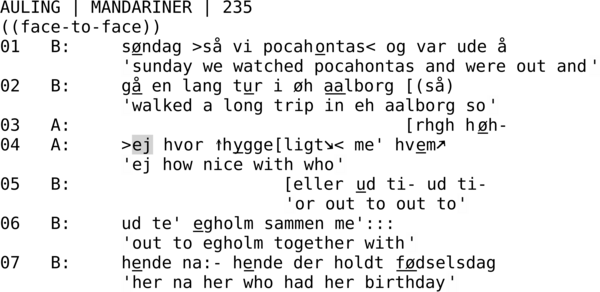Ej
In Danish, the word ej [ɑ͜i] exists both as an adverb and as an interjection. In the written language, we often encounter the adverb ej which means ikke‘not’ or nej ‘no’, but in the spoken language, we mainly hear ej as an interjection. The two versions of ej sound similar and both have negating content, but they are used in different ways and are placed differently in the utterance. Ej in the spoken language begins the main clause or stands alone as the only element in a clause, where ej in the written language most often takes the last position in a sentence and only rarely begins it. The similarity in sound between the adverb and the interjection can be the reason why they are spelled in the same way by its users (e.g. on social media), which is why we use this way of spelling ej in spoken language, though it is also possible to find it transcribed as aj.
The interjection ej can be pronounced in various ways. It can be very short but also long with varying intonation. There seems to be a connection between the interjection’s form and its function. There is a tendency for the short version to be present in constructions where they initiate, for example, an assessing action. It is not the ej in itself that makes the assessment but the action emerges from the residual part of the utterance. Ej as an interjection is therefore more used in a way of marking the subsequent assessing action. This can be seen in line 4 in the following excerpt:

Ej can also appear in a long version which often stand alone in an utterance and where the intonation can have big fluctuations from rising and afterwards falling drastically. This version of ej appears as independent utterances and, in this way, expresses an assessing action on its own. This is illustrated in line 2 and 4 in the following excerpt:
![AULING | MANDARINER | 63 ((face-to-face)) 01 B: [↑mor] har hænge[patter↑ 'mom has saggy tits' 02 A: [e::::j↘ (.) e::j↘ 'e::::j (.) e::j' 03 (0.5) 04 A: [ej::::::h↘] 'ej:::::h' 05 B: [∙hh ]heh og moren har ikk hængepatter 'hh heh and the mother does not have hanging tits'](/fileadmin/_processed_/d/2/csm_ej_eng_2_e1fb0afe87.png)
We have observed a few examples where ej is used to mark topic shift. In these cases, there is nothing immediately noteworthy about the intonation but it is clear that the ejmarks a transition to something new or previously discussed.
Sources and further reading
Hansen and Heltoft (2011) writes briefly about ej, also as an interjection but without incorporating insights from talk in interaction.
Den Danske Ordbog (DDO). Entry on ej. A corpus based dictionary which has ej as a word entry – also as an interjection.
Ordbog over Dansk Talesprog (ODT). Entry on ej.
Steensig m.fl. (2013). Overview article about the work of the DanTIN group (see who are we), where our research on ejis elaborated further.
Tholstrup (2014) gives a thorough analysis of ej in Danish talk in interaction.
Related entries
The Building Blocks of Talk-in-interaction > Word classes/Parts of speech > Interjections and particles
The Building Blocks of Talk-in-interaction > Sounds > Prosody
Social Actions > Evaluating actions > Judgement
Social Actions > Opening and closing activities > Change of activity
